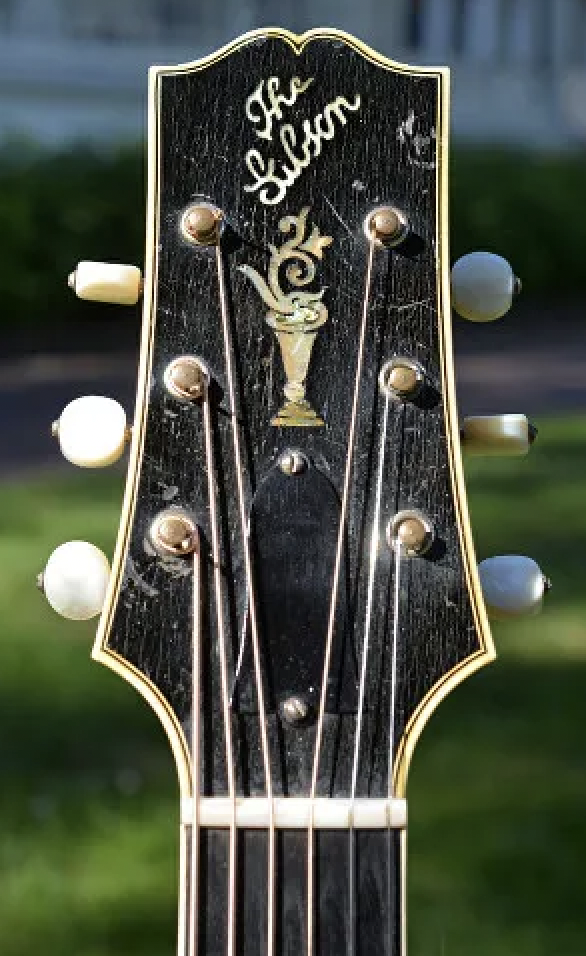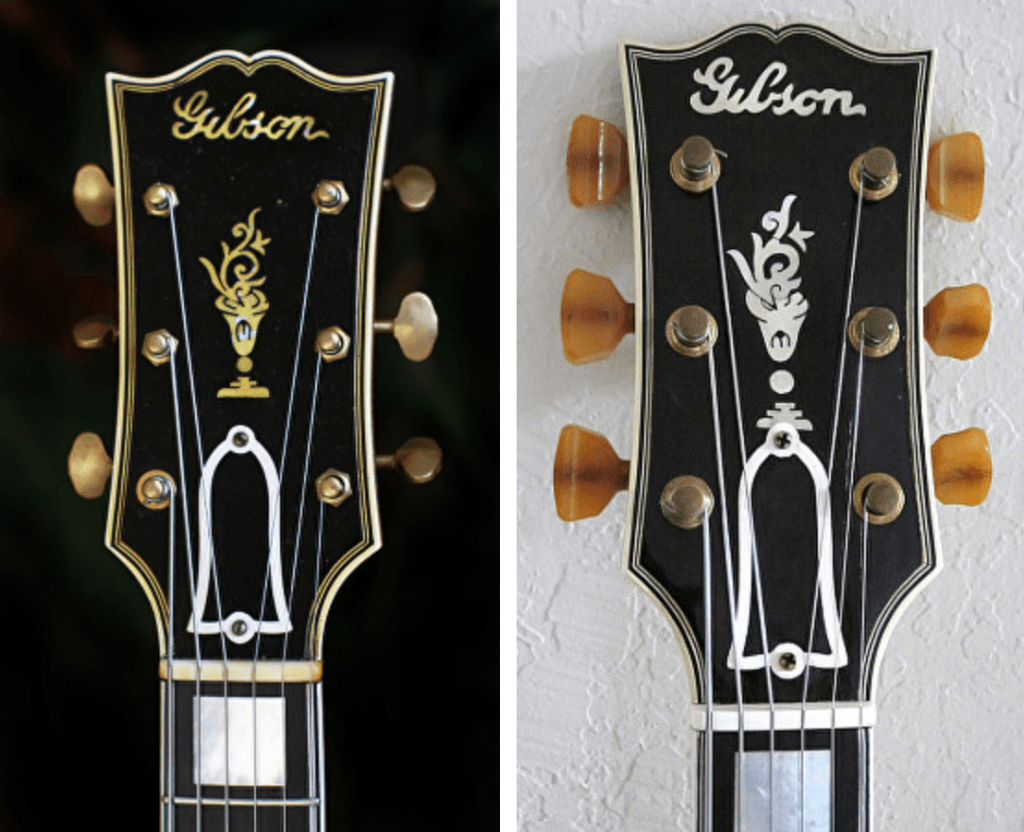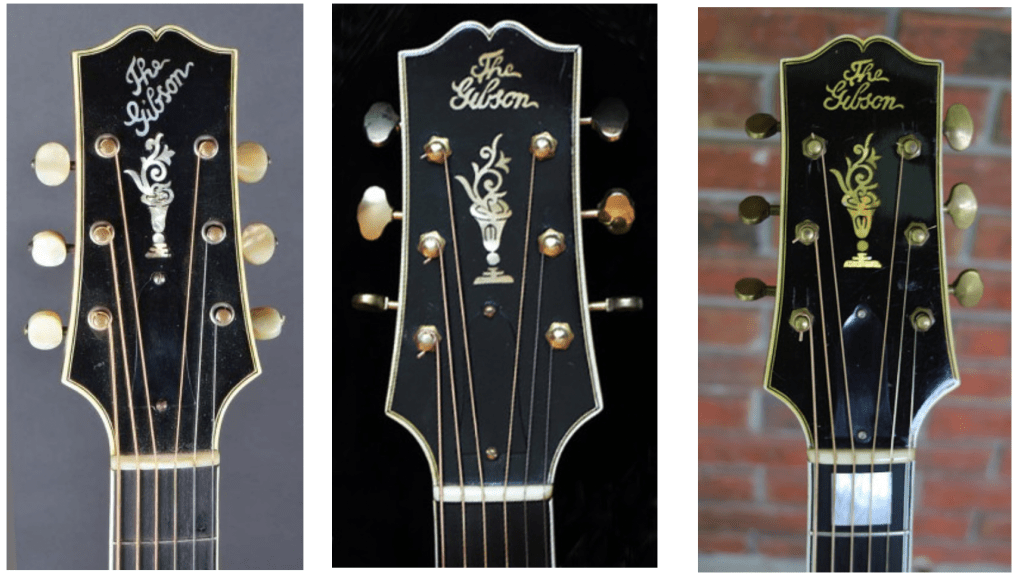Head and neck
Headstock
The tapered headstock (middle image) was a feature of the 16-Inch L-5 from the first production batch that were signed and dated by Lloyd Loar on the 31st of March 1924. The only L-5 known to have been shipped in 1923 (left hand image) had a different headstock shape.
The headstock on the right is wider at the top. Though it first appeared on the L-5 with the introduction of the 17-Inch ‘Advanced’ model in August 1935, all other Gibson guitars had switched to this style of headstock in 1927.

Diagonal ‘The Gibson’ logo
All Loar signed L-5s and many early Type Two L-5s (dot neck) have a pearl ‘The Gibson’ logo that is positioned diagonally on the headstock. The last example with the diagonal logo that we have encountered is a Type Two L-5, serial number 82506, which was shipped in 1928.
The earliest Loar signed L-5s display a diagonal ‘The Gibson’ logo in which the dot above the letter ‘i’ is a separate pearl inlay. Around serial number 77392 this changes so the dot is now an extension of letter ‘T’ above it.


Horizontal ‘The Gibson’ logo
The earliest example on our website with a horizontal ‘The Gibson’ logo is serial number 83659, a Type Two L-5 that was shipped in 1928. Gibson continued to use this style of logo for several years on both Type Two (dot neck) and Type Three (block neck) L-5s. The last example on our site with a horizontal ‘The Gibson’ logo is serial number 93121, a Type Three L-5 that was shipped in 1936.
Script ‘Gibson’ logo
From its introduction in 1923, the Gibson L-5 had a pearl headstock logo that read ‘The Gibson’. Beginning in the early 1930s, this was gradually phased out in favour of a script logo that read ‘Gibson’ (with no ‘The’). The earliest L-5 on our website with the script ‘Gibson’ logo is serial number 85568, a Type Three L-5 that was shipped in 1930. Other examples crop up in 1931 (serial numbers 86940 and 88003) and 1932 (serial number 88439). While it’s possible that the earliest L-5s with the script ‘Gibson’ logo may have been re-necked at the factory, by the mid 1930s the old-style horizontal ‘The Gibson’ logo had largely disappeared (as with all things Gibson, there are a number of exceptions to this rule!)
All 17-inch Pre-War L-5s – both Advanced and Premier – have the script ‘Gibson’ logo (no ‘The’).
Initially, the new logo looked much the same as its predecessor but at some point in the mid-1930s the script became noticeably thicker.

Thin Script ‘Gibson’ logo
The earliest L-5 on our website with the Thin Script ‘Gibson’ Logo is serial number 85568, a Type Three 16-inch L-5 that was shipped in 1930 (as noted above, the earliest L-5s with the script ‘Gibson’ logo may have been re-necked at the factory at a later date). The last L-5 on our website with the Thin Script ‘Gibson’ Logo is serial number 93281, a 17-inch L-5, that was shipped in 1936.
Transition to the Thick Script ‘Gibson’ logo
The earliest L-5 on our website with the Thick Script ‘Gibson’ Logo is serial number 92230, an Advanced L-5 that was shipped in 1935.
Script ‘Gibson’ logo summary
The Thin Script ‘Gibson’ logo was introduced at some point in the early/mid 1930s with the Thick Script ‘Gibson’ logo following a few years later. L-5s displaying both styles of logo were shipped concurrently through 1936, after which virtually all examples have the Thick Script ‘Gibson’ logo. While Advanced L-5s can be found with both style of logo, all of the Premier L-5s on our website have the Thick Script ‘Gibson’ logo.

Headstock Logo in summary
All Loar-signed L-5s have the diagonal ‘The Gibson’ logo. A number of early Type Two L-5s also have the diagonal ‘The Gibson’ logo but by 1929 this had been replaced by a horizontal ‘The Gibson’ logo, which continued in use for several years.
Though the horizontal ‘The Gibson’ logo is found on both Type Two and Type Three L-5s, we have not come across any Type Three L-5s with the diagonal ‘The Gibson’ logo.
By the mid 1930s, the old-style horizontal ‘The Gibson’ logo had largely been replaced by the script logo that read ‘Gibson’ (with no ‘The’).
Flowerpot headstock inlay

The ‘flowerpot’ motif that adorns the headstock of most L-5s was also a feature of the F-5 Master Model mandolin, the launch of which predates the introduction of the L-5 by several months. Earlier still, Gibson F-4 mandolins (built prior to the addition of an adjustable truss rod in 1922) had boasted a full-length version of the flowerpot inlay (sometimes referred to as a ‘double flowerpot’) that extended down into the area later concealed by the truss rod cover.
At some point in the late 1920s, an ‘epsilon’ engraving was added to the main body of the vase, together with a small indent on its upper right-hand side. Though the ‘epsilon’ engraving usually faced down, L-5 serial number 84471 has an upwards-facing epsilon. An exception is Serial No 81271, a Type Two L-5 which was shipped in 1927, which has the earlier style flower pot without the epsilon engraving.
Bearing in mind that the above-described pearl inlays were cut by hand, no two examples are identical and there are numerous small differences that can help determine the period at which a specific guitar was constructed.
The Neck
One Piece Necks
Although most L-5s have a neck constructed from two sections of maple with a dark centre lamination (described by Gibson as a ‘three-piece neck’), in the early 1930s, a number of L-5s were shipped with a one-piece maple neck. All of the examples that we have encountered with a one-piece neck were shipped in 1930, 1931 and 1932 and all unmodified examples have the following combination of features: a horizontal ‘The Gibson’, logo, a 20-fret fingerboard with a pointed end and dots from the third fret, a wrap-over tailpiece and three-on-a-strip Waverly tuners. We have not come across any Advanced or Premier L-5s with a one-piece neck and the block-neck 16-inch L-5s on our website with a one-piece neck (serial numbers 88219, 86343 and 86950) may have had their fingerboards replaced.
Joe Spann, author of ‘Spann’s Guide to Gibson 1902-1941’, comments: “It appears that the L-5s with one-piece necks were made about mid-year in 1930, then required six to eight months to clear out of inventory, which accounts for some having been shipped in early 1931. At that time, 90% of Gibson’s production was banjos. I would think the most likely explanations are that a mistake was made and no one caught it, or that Gibson purchased some larger dimensional timber stock that was sufficiently quarter-sawn for use as one-piece necks.”

Above (left) L-5 serial number 81273, shipped 1927 with ‘three-piece neck’
Above (right) L-5 serial Number 86981, shipped 1931, which has a one-piece neck
The Neck Heel

With the exception of two L-5s that were custom built for Karl Kress (serial numbers 89849 and 91615), all unmodified 16-inch L-5s that we have encountered have a narrow neck heel.
Some early 17-inch Advanced L-5s also have a narrow neck heel (see serial number 92230). The last Advanced L-5 with a narrow neck heel that we have come across is serial number 92576, which was shipped in 1935 and from this point onwards all Advanced L-5s and L-5 Premiers on our site have a wide neck heel.
The Adjustable Truss Rod
The patent for Gibson’s adjustable truss rod was filed on April 5th 1921 and issued on February 27th, 1923. Invented by Plant Manager, Thaddeus ‘Ted’ McHugh and fitted to the L-5 from its introduction, the device is today a feature of virtually all steel string acoustic and electric guitars. Ted McHugh was also responsible for an adjustable tension rod for banjos and the height-adjustable bridge, which he co-invented with Gibson General Manager, L.A. (Lew) Williams.
16-Inch L-5 Truss Rod Position

Left to right: Serial No 76699 shipped in 1924; Serial No 91774 shipped in 1935; Serial No 93121 shipped in 1936
All Type One and most Type Two L-5s have a truss rod cover that is positioned comparatively high on the headstock face. By the early 1930s, examples begin to appear with the truss rod cover positioned noticeably closer to the nut. This isn’t consistent, however, and L-5s can still be found with the truss rod cover in the higher position into the mid 1930s.

“The position of the truss rod pocket and cover had everything to do with how deep the channel was cut for the rod itself,” says luthier Paul Hostetter. “Earlier Gibson necks were quite large and the rod needed to be set deeper, which resulted in the then-typical position of the pocket and cover, below and away from the nut. When Gibson began using slimmer necks, the rod channel wasn’t (indeed couldn’t be) cut so deep, so the pocket ended up closer to the nut. Slimmer necks are also much easier to adjust! Some of those huge Gibson necks were so thick and rigid that the truss rod did virtually nothing!”

The Fingerboard


16-inch L-5s
20-fret dot fingerboard with a pointed end
All Loar-signed L-5s and most Type Two 16-inch L-5s have a 20-fret fingerboard with a pointed end. A few examples exist with a 19-fret fingerboard with a pointed end (see serial number 89511).
Block fingerboard with a pointed end
Some early block inlaid fingerboards have a 20-fret fingerboard with a pointed end (the earliest example on our website is serial number 85576, which was produced in 1929 and shipped in 1930).
Though this style of fingerboard continues through to the mid 1930s (the latest example on our website is serial number 91440, which was shipped in 1935), a number of Type Three L-5s were also shipped with a 19-fret block fingerboard with a pointed end (the earliest example on our website is serial number 86949, which was shipped in 1931 and the latest is serial number 91917, which was shipped in 1935).
Block fingerboard with a square end
A third style of fingerboard was available over the same time-period and this had a 19-fret block fingerboard with a square end.
Narrow Block Inlays
A number of 16-inch L-5s shipped in the mid to late 1930s have a 20-fret fingerboard with a pointed end and narrow block inlays from the first to 17thfrets. This is the same style of fingerboard found on earlier 17-inch Advanced L-5s and may indicate that these guitars may were returned to the factory to be re-necked or fitted with a new fingerboard. Alternatively, Gibson may have been fitting new-style necks and/or fingerboards to existing old stock 16-inch bodies. For example, L-5 serial number 93121 was shipped in 1936 but has an FON that indicates that it has a pre-1935 16-inch body.
To further confuse the issue, examples exist with a 19-fret fingerboard with narrow block inlays and a square end (see serial numbers 88484 and 88783)!
17-inch Advanced L-5s
All Advanced (17-inch) L-5s were fitted with a fingerboard with a pointed end. While most have a 20-fret fingerboard, a few early examples were built with a 19-fret fingerboard (see serial number 92230).
Fingerboards in Summary
Most Type One (dot inlaid) 16-inch L-5s have a 20-fret fingerboard with a pointed end.
Type Three 16-inch L-5s can be found with:
A 20-fret block fingerboard with a pointed end
A 19-fret block fingerboard with a pointed end
A 19-fret block fingerboard with a square end. This is by far the commonest variation.
Advanced L-5s have a fingerboard with a pointed end. A few early examples were shipped with a 19-fret fingerboard.
Fingerboard Inlays – Dot Necks
Dots from the 5th fret
Most Loar-signed L-5s have dot inlays from the 5th fret, with double dots at the 12th fret.
Dots from the 3rd fret
In the late 1920s through to the early 1930s, some Type Two L-5s were shipped with a 20-fret fingerboard with dots from the 3rd fret.
Double dots 12th and 17th frets
L-5 serial number 80264 (signed and dated by Lloyd Loar on December 1st 1924 and shipped in 1926) has double dots at both the 12th and 17th frets. There are also a number of L-5s on our site that were shipped in 1927 and one shipped in 1929 that have this feature.
Fingerboard Inlays – Block Necks
16-inch L-5s with wide blocks from fret three:
The earliest Type Three L-5s on our site have wide blocks from fret three.
16-inch L-5s with wide blocks from fret one:
L-5s with wide blocks from the first fret appeared around the same time (see serial numbers 87990 and 88439, which were shipped in 1931 and 1932 respectively) and both styles run concurrently.
16-inch L-5s with narrow blocks from the first fret:
Following the introduction of the Advanced 17-inch L-5 in 1935, a number of 16-inch L-5s were shipped with a similar fingerboard, which had narrow block inlays from the first to 17th frets.
17-inch L-5s with wide blocks:
Some early Advanced L-5s have wide block inlays like the 16-inch L-5s that preceded them (see serial numbers 92230, 92284 and 92296, all of which were shipped in 1935).
17-inch L-5s with narrow blocks:
L-5 serial number 92301 (shipped in 1935) and all later Advanced L-5s have narrow block inlays.
Scale Length
From its introduction in 1923, the L-5 had a 24 ¾ inch scale length. Beginning in 1936, a number of Advanced L-5s were listed as ‘Spl L-5’ (22 units in 1936 and approximately 62 the following year). The ‘Special’ appellation may have indicated early use of the longer 25-½ inch scale length that became a permanent feature of the L-5 in 1938 and it seems likely that for a time at least both short and long scale L-5s were shipped concurrently. A number of examples exist with an extra long 26 inch scale (Serial Number 95674).
